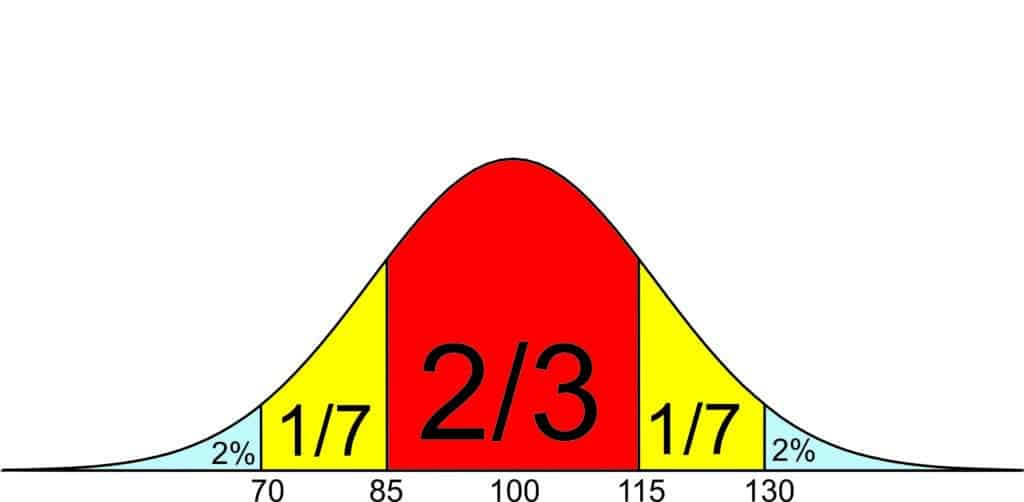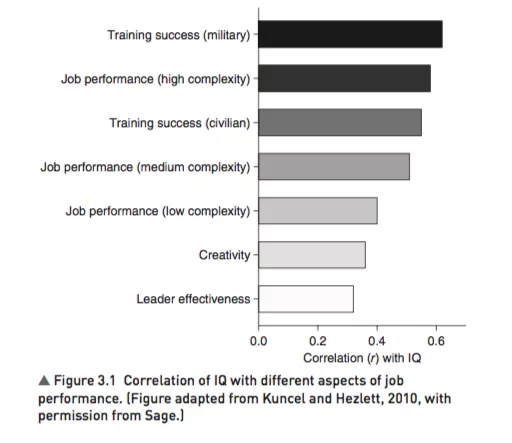IQ stands for ‘Intelligence Quotient’ and is a numerical score based on standardized tests which attempt to measure general intelligence. However, an IQ test does not measure intelligence in the same way a ruler might measure the height of a person.
Instead, IQ scores are always relative to the median score (typically 100) that reflects the general intelligence of the population. As such, it is challenging to compare scores across different populations or cultures.
Modern IQ tests measure a person’s ability to reason and use information to solve problems through questions and puzzles. Some of the things that an IQ test will typically measure are short-term and long-term memory, how well a person can solve puzzles, and how quickly. Because there is no single standardized test that measures intelligence, determining the highest IQ ever will always be contentious.
Bearing these caveats in mind, it is generally believed that the highest IQ score ever recorded is that of William James Sidis, who is believed to have had an IQ of between 250 and 300. This would place him in the top 0.000001% of the population in terms of intelligence. To put this into perspective, the average IQ is 100, and a score of 130 or above is considered to be “gifted.”
Sidis was a child prodigy who was able to read at the age of 18 months and could speak several languages fluently by the time he was a teenager. However, some critics claim his score may have been inflated due to the media attention he received as a child prodigy.
The most reliable record-high IQ score belongs to mathematician Terence Tao, with a confirmed IQ of 230.
How IQ is measured
People have always been aware that some are better at mental tasks than others, but it wasn’t until a French psychologist by the name of Alfred Binet that a qualitative lens was cast on the diversity of human intelligence. Together with colleague Théodore Simon, in 1905, the psychologists devised the Binet-Simon test, which focused on verbal abilities and was designed to gauge ‘mental retardation’ among school children.
These tests, which in time also included questions that gauged attention, memory, and problem-solving skills, quickly showed that some young children were better able to answer complex questions than older children. Based on this observation, Binet concluded that there is such a thing as ‘mental age’ which can be higher or lower than a person’s chronological age.
In 1916, Stanford University translated and standardized the test using a sample of American students. Known as the Stanford-Binet Intelligence Scale, this test would go on to be used for decades to quantify the mental abilities of millions of people around the world.
The Stanford-Binet intelligence test used a single number, known as the intelligence quotient (or IQ), to represent an individual’s score on the test. This score was computed by dividing a person’s mental age, as revealed by the test, by their chronological age and then multiplying the result by 100. For instance, a child whose chronological age is 12 but whose mental age is 15 would have an IQ of 125 (15/12 x 100).
The Stanford-Binet Intelligence Scale – Fifth Edition test measures five content areas, including fluid reasoning, knowledge, quantitative reasoning, visual-spatial processing, and working memory.

Building upon the Stanford-Binet test, psychologist David Wechsler developed a new IQ test that better measures a person’s different mental abilities. The first test, known as the Wechsler Adult Intelligence Scale (WAIS), was released in 1955. Later, Wechsler released two different IQ tests: one specifically designed for children, known as the Wechsler Intelligence Scale for Children (WISC), and the other designed for adults, known as the Wechsler Preschool and Primary Scale of Intelligence (WPPSI). The modern adult version of the test is known as the WAIS-IV and has gone through numerous revisions to accommodate recent research.
A WAIS-IV is made of 10 subtests and 5 supplemental tests, which score an individual in four major areas of intelligence: a Verbal Comprehension Scale, a Perceptual Reasoning Scale, a Working Memory Scale, and a Processing Speed Scale. These four index scores are combined into the Full-Scale IQ score (what people generally recognize as the ‘IQ score’). There’s also the General Ability Index which is based on six subset scores, which are good at identifying learning disabilities. For instance, scoring low in some areas of the General Ability Index but scoring well in other areas may indicate a specific learning difficulty, perhaps warranting specialized attention.
The modern WAIST test does not score IQ based on chronological and mental age but rather based on the scores of other people in the same age group. The average score is fixed at 100, with two-thirds of the population scoring between 85 and 115, while at the extremes, 2.5% of the population scores above 130 and 2.5% scores below 75. Basically, the IQ score moves 15 points in either direction with each standard deviation.
Some IQ tests measure both crystallized and fluid intelligence. Crystallized intelligence refers to knowledge and skill gained through life, meaning it’s based on facts and grows with age. Situations that require crystallized intelligence include reading comprehension and vocabulary exams.
For instance, a test might ask “what’s the difference between weather and climate” or “who was the first president of the United States”. These sorts of questions test a person’s knowledge of things that are valued in a certain culture. A person from India might not know the answer to many IQ test questions given in the US, but that doesn’t make them any less intelligent.
Fluid intelligence, on the other hand, is the ability to reason, solve problems, and make sense of abstract concepts. This ability is considered independent of learning, experience, and education. For example, participants of an IQ test might have to figure out what a shape would look like if it were rotated by 90 degrees.
What’s the highest IQ score ever?
When IQ scores are plotted on a graph, they follow what’s known in statistics as a ‘bell curve’. The peak of the “bell” lies at the mean, where the majority of IQ scores lie. The bell then slopes down to each side; one side represents scores that are lower than the average, and the other side represents scores that are above the average. Where the slope of the bell trails off, you’ll find the extremely high (gifted) and extremely low (disabled) IQ scores. Most people have average intelligence.
IQ scores can be interpreted in brackets, as follows:
- 1-70: low;
- 71-84: below average;
- 85-115: average;
- 116-130: above average;
- 130-159: high;
- 160+: genius.
The problem is that IQ tests can get really fuzzy in the uppermost bracket, the reason being that the higher the IQ, the smaller the population group there is to use for scoring against. For instance, people with an IQ of 160 have a population size of only 0.003% — that’s only 3 out of 100,000 people. That being said, although there is no known upper IQ limit, all of this implies some practical limitations when evaluating the IQ of super-gifted individuals.
Was William Sidis the most intellectually gifted person in the world?
This brings the question: who’s the person with the highest IQ ever? According to some, that would be William James Sidis (1898-1944), with an IQ estimated between 250 and 300. A true child prodigy, Sidis could read English by the time he was two and could write in French by age four. At age five, the young Sidis devised a formula whereby he could name the day of the week for any given historical date.
When he was eight, he made a new logarithmic table based on the number 12. At age 12, Sidis was admitted to Harvard where he wrote theories on “Fourth Dimensional Bodies” and graduated cum laude before his sixteenth birthday. At this age, Sidis could already speak and read fluently in French, German, Russian, Greek, Latin, Armenian, and Turkish.
Young Sidis’ achievements did not fly under the radar, with the foremost newspapers of the time following his academic record and reporting outlandish stories. But journalists also constantly harassed the young Sidis, who came to loathe the press and the “genius” staple. The celebrity and pressure might have gotten to him in the end.
After a brief stint in 1918 teaching at Rice University in Texas, Sidis went through various clerk jobs. Reclusive in nature, all Sidis wanted in life was a job that paid his most basic expenses and which made no further demands from him. Sidis died poor and with not much to show in terms of academic achievements. Harvard professors would speak of the young Sidis, while he was still attending the university, that he would grow to be the greatest mathematician in the world. His only published work is a three-hundred-page treatise on collecting streetcar transfers. According to American Heritage:
“The book, Notes on the Collection of Transfers, contains densely printed arcana about various interconnecting lines, scraps of verse about streetcars, and some simple, foolish streetcar jokes that the author might have enjoyed in his childhood, had he had one. Sidis published it under the unlovely pseudonym of Frank Folupa, but reporters managed to ascribe the book to him, tracked him down, and again he fled.”
Sidis’ IQ is said to have been tested by a psychologist, and his score was allegedly the very highest ever recorded. William Sidis took general intelligence tests for Civil Service positions in New York and Boston, gaining phenomenal records which are the stuff of legends. But this information could not be verified at this date, and perhaps never will be.
Terence Tao: the man with the highest confirmed IQ score
The most reliable record-high IQ score belongs to Terence Tao, with a confirmed IQ of 230. Tao is an Australian-American mathematician born in 1975, who showed a formidable aptitude for mathematics from a very young age. He entered high school at the age of 7, where he began taking calculus classes. He earned his bachelor’s degree at 16 and his Ph.D. degree at 21.
Tao, who reportedly had a normal social life while growing up and is now married with children, really exploited his talent. Over the years, Tao has garnered a bevy of prestigious awards for his work, including the Fields Medal (which is like the Nobel Prize of math), and the MacArthur Foundation grant (which is often referred to as the “genius prize”). At the moment, Tao is a professor of mathematics and the James and Carol Collins Chair at the University of California (UCLA).
In an interview with National Geographic, Tao rejected lofty notions of genius, claiming that what really matters is “hard work, directed by intuition, literature, and a bit of luck.”
The second highest confirmed IQ belongs to Christopher Hirata, with an IQ of 225. He was only 13 years old when he won the gold medal in 1996 at the International Physics Olympiad. From age 14 to 18, Hirata studied physics at Caltech, graduating with a bachelor’s degree in 2001. While at Caltech, Hirata did research for NASA on the colonization of Mars and received his Ph.D. in 2005 from Princeton University in Astrophysics.
The 36-year-old works for NASA where he supervises the design of the next generation of space telescopes. His theoretical research deals with Cosmic Microwave Background (CMB), dark energy and accelerated expansion of the universe, galaxy clusters, and the large-scale structure of the universe. In 2018, Hirata was awarded the prestigious New Horizons in Physics Breakthrough Prize for fundamental contributions to understanding the formation of the first galaxies in the universe and for sharpening and applying the most powerful tools of precision cosmology.
Terence Tao and Cristopher Hirata have both taken actual IQ tests, but you’ll find on the internet so-called “top 10 smartest people” lists that include many individuals who have never been tested. For instance, some websites include in their lists people such as Gary Kasparov (IQ 180), Johann Goethe (IQ 225), Albert Einstein (IQ 160), and even personalities like Leonardo da Vinci (IQ 160) or Isaac Newton (IQ 190) who lived centuries before the intelligence tests were invented. These scores are estimated based on the individuals’ biographies so they shouldn’t be trusted, which doesn’t mean such famous personalities weren’t highly intelligent individuals — after all, the magnitude of their success speaks for itself.
How much does an IQ score matter?

According to the scientific literature, a person’s IQ is highly correlated with measures of longevity, health, and prosperity. According to one study involving one million Swedes, having a high IQ also protects people from the risk of death — so much so that there was a three-fold difference in the risk of death between the highest and the lowest IQs.
IQ is also positively correlated with career success, unsurprisingly showing that more intelligent people make for better employees (see graph below). The correlation is not perfect though — measured from -1 to 1, where a correlation of 1 would mean in this case that every IQ point would result in an incremental increase in career success — so there’s plenty of room for other factors not measured by standard intelligence tests that explain success.
That being said, there’s a lot of leeway as to what makes a person successful or helps him or her master a craft. Luck certainly plays a role (terminal illness on one end of the negative extreme or having a loving, wealthy family while growing up at the other end of the positive extreme). But then there’s a far more important and, at the same time more controllable, variable: that’s grit.
Angela Duckworth, a psychologist at the University of Pennsylvania in Philadelphia, interviewed people from all walks of life, attempting to determine what characteristics made some of them successful in life.
She found grit was the one trait that stood out among the people who had ‘made it’. Grit, Duckworth told Science News, has two parts: passion and perseverance. In one of her studies, Duckworth found that students with higher grades in university tended to have more grit (unsurprisingly). However, students with higher university entrance exam scores tended to be less gritty than those who scored lower. In other words, by the end of university, grit is a better predictor of success (graduation score) than intelligence (as measured by entrance-exam scores).
Let’s talk a bit about the higher end of achievement, or what’s traditionally considered the domain of geniuses. In the early 21st century, Professor Lewis M. Terman evaluated a large sample of children who score at the top end of the IQ scale and followed them as they aged to see if they would become veritable geniuses in adulthood. By the end of his evaluation, the researcher wound up with 1,528 extremely bright boys and girls who averaged around 11 years old. Their average IQ was 151, with 77 children claiming IQs between 177 and 200 — that’s on the extremely gifted scale.
Until they reached middle age, the original study participants (affectionately called “Termites”) were periodically tested, the results of which were included in the five-volume work, entitled The Genetic Studies of Genius. No one among the study’s participants went on to achieve what society truly deems genius — a person who has made an outstanding contribution in a certain field of study, let’s say.
Many became more or less successful lawyers, engineers, doctors, scientists, and other respectable professionals. Although we should bear in mind many of the participants grew up between the two world wars, it’s perhaps surprising to learn that many other participants were far less likely to graduate from college or to attain professional or graduate degrees.
When the IQs of the most successful Termites were compared to the comparatively least successful ones, researchers found little differences, suggesting intelligence is not a good predictor for high achievement. As chances have it, this fact is nowhere better illustrated than the cases of Luis Walter Alvarez and William Shockley, Nautilus wrote. When they were little boys, the two were tested by Terman but didn’t make the cut.
However, both were monumentally successful. Alvarez went on to become one of the most brilliant and productive experimental physicists of the 20th century, earning the 1968 Nobel Prize in Physics. Shockley earned his P.h.D. from MIT and wrote his first patent at age 28. In 1956, he shared the Nobel Prize in Physics with two other colleagues for inventing a device without which our rich digital lives would be all but impossible — that’s the transistor. No Termite ever won a Nobel Prize.
Yes, having a high IQ score is a good predictor of achieving success and living a better life than the mean — it’s a nice head start, but that’s not enough in and of itself. You can make up for a lack of special aptitude (as perceived by an IQ score) through grit, resilience, and working on something you truly love to do.
Did you ever take an IQ test? Share your results and opinion on the matter in the comment section below.
[UP NEXT] Can you raise your IQ score?








